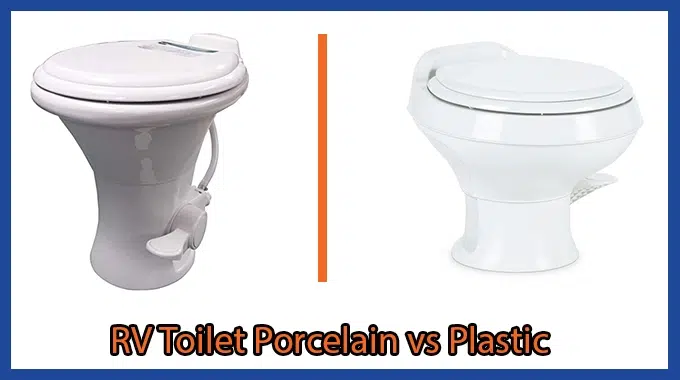Last Updated on May 11, 2023
RV toilets are essential for disposing of waste when traveling in a recreational vehicle. Not only do they provide a convenient place to relieve oneself, but they also help to keep the RV clean and sanitary. There are two main types of RV toilets: porcelain and plastic.
Although they both serve the same purpose, there is no doubt that porcelain RV toilets are durable, less likely to fade over time, and more comfortable to sit in. A plastic toilet is lighter and easier to install than a porcelain toilet and is designed to fit into small spaces.
Regardless of your toilet type, you should ensure it is clean and properly working. Find out how each type of RV toilet differs from the others to make the appropriate decision based on your needs.
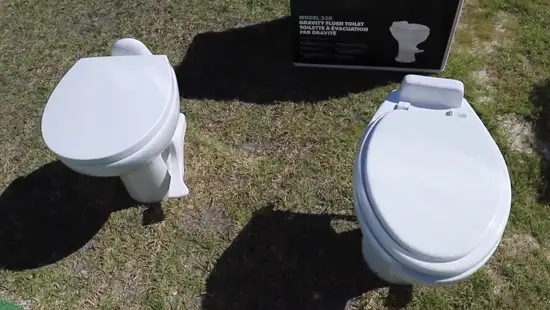
Differences Between RV Toilet Porcelain vs Plastic
When choosing an RV toilet, you must decide between a porcelain or plastic model. While both materials are strong and durable, there are some key differences to consider:
Durability
Both types of toilets have pros and cons, but when it comes to durability, porcelain wins out. Porcelain toilets are made from a more rigid material than plastic, making them less likely to scratch or chip. Also, porcelain toilets are less susceptible to staining than plastic models.
Weight
Plastic toilets are going to be much lighter than porcelain toilets. This is because porcelain is a lot thicker and more robust than plastic. Also, if you drop a plastic toilet, it is more prone to breaking than a porcelain flush toilet.
Comfort
Porcelain toilets are more comfortable, as they are smooth and easy to clean. These toilets are more similar to traditional toilets, which means they are also usually comfortable. They also tend to be quieter and more subdued than plastic toilets.
Installation
When it comes to installation, porcelain toilets are generally more challenging than plastic toilets. This is because porcelain toilets need to be anchored to the floor, while plastic toilets can simply be bolted to the floor or wall.
Weight Capacity
Porcelain toilets usually have a higher weight capacity than plastic toilets. This means that they can accommodate more weight without breaking or becoming damaged. Since porcelain is stronger and denser than plastic, it is much more robust.
Advantages & Disadvantages of Porcelain RV Toilets
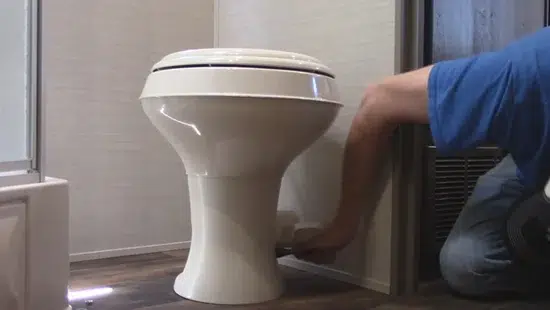
Porcelain RV toilets are becoming increasingly popular among Rvers for several reasons. They have several advantages & disadvantages, including:
Advantages:
- Porcelain RV toilets are durable and resistant to staining, fading, and chipping.
- Due to the smooth surface of porcelain, waste does not adhere to the sides of the toilet, making it easier to maintain.
- Typically, the bowl of a porcelain RV flush toilet is taller than a plastic RV toilet, which makes sitting more comfortable.
- Its black water tank serves as a storage area for wastewater until it is flushed.
- They are more comfortable to use and will last longer with proper care.
Disadvantages:
- Porcelain RV toilets are generally more expensive than plastic RV toilets.
- They are also heavier and harder to install.
- These toilets require more maintenance than plastic toilets.
- A more frequent cleaning and a more frequent refill of the tanks with water are required.
Advantages & Disadvantages of Plastic RV Toilets
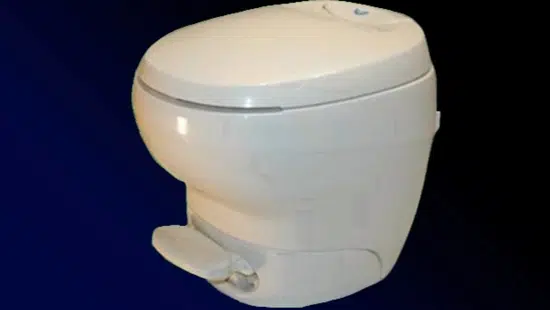
In the past, most RVs were equipped with ceramic toilets, but today, many manufacturers opt for plastic toilets. There are several advantages & disadvantages to using a plastic toilet in an RV:
Advantages:
- Plastic RV toilets are much lighter than ceramic toilets, making them easier to install and less likely to damage the RV floor.
- These toilets are less likely to crack or break if they are dropped or accidentally bumped.
- They are generally less costly than porcelain toilets, making them a more budget-friendly option for RV owners.
- Because they’re non-porous, you won’t have to spend as much time scrubbing your toilet bowl with a toilet bowl cleaner.
Disadvantages:
- Plastic RV toilets are not as durable as porcelain ones and may fade or stain over time.
- The plastic RV toilet bowl is usually shorter than a porcelain RV toilet, which makes it less comfortable to sit on.
What are RV Toilets Made of?
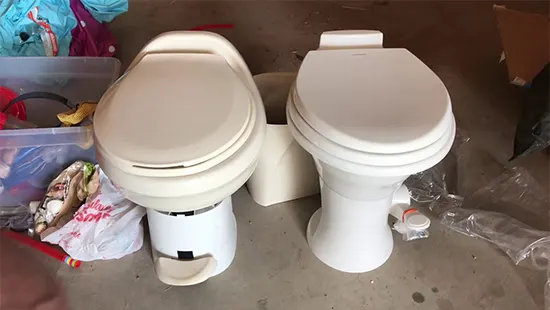
RV toilets are made from sturdy materials (such as hard plastic & porcelain) that can support years of use. Residential RV toilets typically have a porcelain base, a ceramic type that is durable and easy to maintain. Most bowls and tanks are made of plastic, which is lightweight and durable.
Depending on the manufacturer, seats, and lids are typically made from either plastic or wood. The seal that prevents waste from escaping is among the most critical components of an RV flush toilet. This seal is typically made from rubber or silicone, and it is essential to regularly inspect it for signs of wear and tear.
Although there are some slight differences between the types of RV toilets, there are some similarities. Porcelain RV toilets are made from fired clay that is glazed to give it a smooth, non-porous surface. Plastic RV toilets are made from lightweight hard plastic less likely to break than porcelain.
Are Porcelain or Plastic RV Toilets Interchangeable?
Many believe that porcelain and plastic RV toilets are interchangeable, but this is not always the case. While most models will fit into the same basic space, there can be differences in the connection type and the size of the waste outlet.
Although both types of toilets are designed for use in RVs, they are not identical. Porcelain toilets are made of vitreous china, a type of ceramic fired at high temperatures to make it strong and durable.
The plastic toilet is made from polymers molded into a shape. These materials have different properties, meaning they cannot be used interchangeably. For example, porcelain toilets are less likely to stain and more resistant to scratches than plastic toilets. So it is clear they are not the same.
Can you replace a Plastic RV toilet with a porcelain toilet?
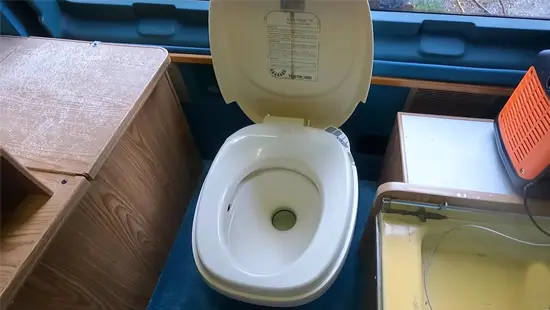
Porcelain toilets are an alternative to plastic RV toilets and are a popular option for many homeowners. You can replace your RV’s plastic toilet with a porcelain one. But, there are a few things to remember when replacing a plastic toilet with porcelain for your RV:
- Depending on the installation method, it may require special consideration.
- You may be unable to fit the updated toilet in the same space as your old one.
- Your plumbing may need to be adjusted to accommodate the new toilet.
- There will be a higher price for the porcelain toilet than for the plastic RV toilet.
- The porcelain toilet will be heavier than the plastic RV toilet, which could affect your RV’s weight distribution.
If you accept these challenges, it may be possible to replace your RV’s plastic toilet with a porcelain one. But if you’re uncomfortable making changes, it might be wise to stick with a plastic RV toilet.
How Do I Replace My Plastic RV Toilet With Porcelain?
If your RV toilet is made of plastic, you may wonder how to replace it with a porcelain one. While finding replacement parts for your RV toilet is possible, it is often easier and might be cheaper to replace the entire unit simply. Here are the steps you need to follow to replace your plastic RV toilet with porcelain:
- Remove the old plastic toilet from its mounting bolts. You’ll need a screwdriver or power drill for this. Be careful not to damage the flange or surrounding area as you remove the old toilet.
- Test fit the new porcelain toilet on the bolts to make sure it’s the right size.
- Apply a generous amount of plumbers putty around the flange.
- Place the new toilet on the flange, ensuring its level and secure. Use a level to check that it’s straight before moving on.
- With the new toilet, install the mounting bolts and tighten them. Hand-tighten them first, then use a power drill to finish tightening them down.
- Connect the water supply line to the fill valve and open up the valve to test if there are any leaks. Check around the toilet’s base and under the tank for any signs of water leaks.
- If there are no leaks, you’ve successfully replaced your RV toilet plastic with porcelain.
Does the Manufacturer Make Porcelain Toilets for RV?
There is a wide variety of porcelain toilets available on the market today, and many RVers are wondering if there are any manufacturers that make porcelain toilets specifically for RVs. The answer is yes.
Several manufacturers produce porcelain toilets for RVs, and these toilets are designed to meet the unique needs of RVers. If you’re looking for a top-quality porcelain toilet for your RV, you’ll want to check out the selection from the manufacturer.
These toilets are made with unique high-strength porcelain that can withstand the rigors of life on the road. Also, they feature a unique flushing system that delivers a powerful flush every time. The manufacturer also offers a wide variety of models to choose from, so you’re sure to find one that fits your needs.
Why are Porcelain RV Toilets Heavier than Plastic Toilets?
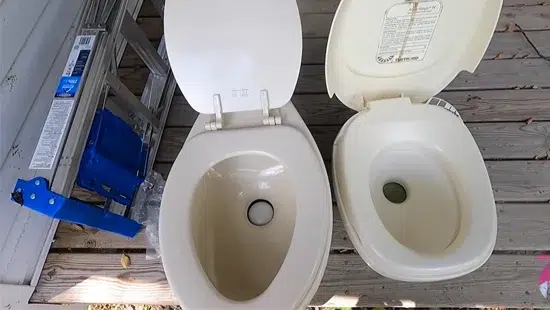
The weight of an RV toilet is determined by the material it is made from. Porcelain RV toilets are usually heavier than plastic toilets because they’re made of a different & denser material.
Porcelain is a type of ceramic fired in a kiln, which gives it a tougher surface. On the other hand, plastic is made out of a synthetic polymer that can be molded into different shapes.
The weight difference between a porcelain and plastic toilet can be significant, with some porcelain toilets weighing twice as much as their plastic counterparts. The extra weight of porcelain toilets can make installation more challenging, but the long-term durability and performance of porcelain toilets often justify the extra cost.
Why are Plastic RV Toilets Less Expensive than Porcelain RV Toilets?
A significant reason why plastic RV toilets are more affordable than porcelain RV toilets is that they tend to yellow over time while porcelain remains white. Yellowing can make cleaning the toilet more complicated and make it more challenging to see whether the bowl has been cleaned.
Toilets are made from molded polyethylene, a cost-effective and easily molded material. They may crack or break more easily and become stained and discolored with prolonged use. The plastic RV toilet is also less comfortable than a porcelain RV toilet because it is hard and cold to the touch.
How Much Does a Porcelain RV Toilet Weigh?
The total weight of a porcelain RV toilet includes the tank, which can weigh up to 30 to 50 pounds when full. The actual weight will depend on the specific model and manufacturer. For example, a small, single-piece unit may weigh as little as 30 pounds, while a larger, two-piece unit with a threaded black tank may weigh closer to 50 pounds.
A heavier toilet is more likely durable and stable, but it will also be difficult to install. If you have a small RV or are worried about saving weight, you may want to choose a lighter model. But, if stability is your top priority, you should opt for a heavier toilet.
How Much Weight Can a Plastic RV Toilet Hold?

The amount of weight a plastic RV toilet can hold will vary based on the specific product. But, most plastic RV toilets are designed to hold up to 300 pounds. This is enough weight to accommodate most adults and children.
The main reason for this weight limit is to prevent the toilet from tipping over. Although the toilets are designed to be sturdy, they are not indestructible. If too much weight is placed on the toilet, it could break, resulting in serious injuries. So, the manufacturer’s weight limit recommendations should always be followed.
Porcelain or Plastic – What Type of RV Toilet is Best for You?
Most RVs come with a porcelain toilet, but some models feature a plastic toilet. So, which type of toilet is best for you? If you prioritize durability and easy maintenance, then a porcelain toilet is likely the best choice for you. But, if you’re looking to save money and don’t mind sacrificing some durability, a plastic model may be the better option.
When choosing the right RV toilet, these factors need to be considered. Each option has its advantages and disadvantages. Ultimately, the best RV toilet for your RV will depend on your personal preferences and budget.

